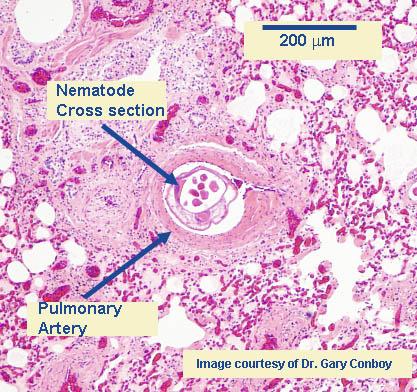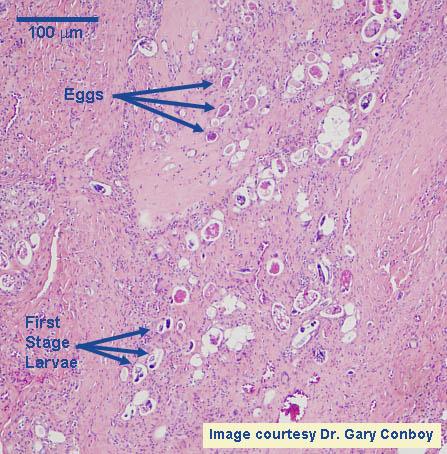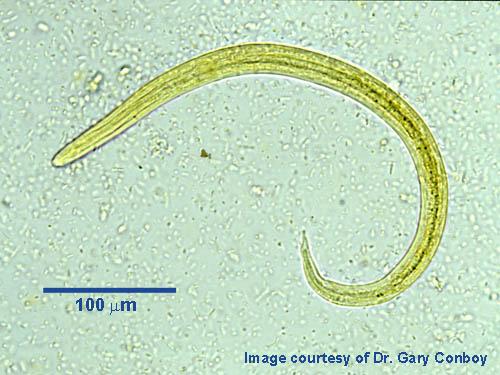
Angiostrongylus vasorum
Angiostrongylus vasorum occur in dogs, foxes, coyotes and lynx. So far in Canada, the parasite is only found in the Avalon Peninsula of Newfoundland. It's also found in South America, Europe and Africa.
Overview
Angiostronglylus vasorum, or French heartworm, is a recently introduced cardiopulmonary nematode of wild and domestic canids in Canada, currently established only in the Atlantic provinces. It is a metastrongyloid lungworm in the Family Angiostrongylidae, related to Aelurostrongylus of felids. It undergoes an indirect life cycle involving gastropod (slug or snail) intermediate hosts. Clinical significance is similar to Dirofilaria immitis in dogs, although A. vasorum is generally considered more pathogenic. Diagnosis relies on detection of characteristic first stage larvae in feces or airways. Prophylactic treatment is advised in endemic regions during the frost-free season. It is not considered a zoonosis.
Taxonomy
Phylum: Nematoda
Class: Secernentea
Order: Strongylida
Superfamily: Metastrongyloidea
Family: Angiostrongylidae
Angiostrongylus vasorum is the only species in this genus of veterinary importance in Canada. This parasite is related to the rat lungworm Angiostrongylus cantonensis, an important zoonosis in Asia and the Pacific.Note: Our understanding of the taxonomy of parasites is constantly evolving. The taxonomy described in wcvmlearnaboutparasites is based on Deplazes et al. eds. Parasitology in Veterinary Medicine, Wageningen Academic Publishers, 2016.
Morphology
Adults are small (< 25 mm long), red and white nematodes that inhabit the pulmonary arteries and right heart. First-stage larvae are approximately 300 to 400 µm long and have a distinctive kinked tail with a dorsal spine.
Host and Geographic Distribution Occurrence and Significance in Canada
Definitive hosts for Angiostrongylus vasorum are wild and domestic canids, including dogs, red foxes, and coyotes. Lynx and mustelids are also potential definitive hosts. In Canada, this parasite has been confirmed in Newfoundland and, most recently, Nova Scotia. Atlantic provinces and states should be considered at risk. This parasite may also be present in dogs imported from South America, Europe, and Africa. This parasite is considered emerging (increasing in prevalence and distribution) in North America and Europe.
Life cycle and epidemiology

Pathogenesis

Clinical signs
Dogs infected with A. vasorum may show no clinical signs, while others range from mild to severe clinical signs, and occasionally death. If clinically affected, dogs present with exercise intolerance, coughing, and dyspnea, progressing to right heart failure in advanced cases (ascites). Compromised haemostasis also occurs, and rarely neurological signs from larval migrans in the central nervous system n may be observed.
Diagnosis
Treatment and control
There are no anthelmintic treatments approved for Angiostrongylus vasorum in Canada. Monthly prophylaxis with milbemycin or moxidectin is recommended in endemic regions (Atlantic Canada) during the frost free season. Fenbendazole and macrocyclic lactones are effective treatments for adult nematodes but complications may occur (dyspnea, ascites). Supportive therapy is often needed in severely affected dogs. Preventing dogs from hunting gastropods, frogs, or birds can reduce risk of exposure.
Public health significance
Angiostrongylus vasorum is not known to be zoonotic. Other species of the genus (e.g. A. cantonensis) are zoonotic, but are not found in Canada.
References
Conboy G (2011) Canine angiostrongylosis: the French heartworm: an emerging threat in North America. Veterinary Parasitology 176: 382-389.
Deplazes et al. eds. (2016) Parasitology in Veterinary Medicine. Wageningen Academic Publishers, 653 p.
Koch J et al. (2009) Canine pulmonary angiostrongylosis: an update. The Veterinary Journal 179: 348-359.
Bourque A et al. (2005) Angiostrongylus vasorum infection in a coyote (Canis latrans) from Newfoundland and Labrador, Canada. Journal of Wildlife Diseases 41: 816-819.
Conboy G (2004) Natural infections with Crenosoma vulpis and Angiostrongylus vasorum in dogs in Atlantic Canada and their treatment with milbemycin oxime. Veterinary Record 155: 16-18.
Perry AW et al. (1991) Angiostrongylosis with disseminated larval infection associated with signs of ocular and nervous disease in an imported dog. Canadian Veterinary Journal 32: 430-431.
Priest et al. (2018) First report of Angiostrongylus vasorum in coyotes (Canis latrans) in mainland North America. Veterinary Record doi: 10.1136/vr.105097
https://research-groups.usask.ca/cpep/parasites/metastrongyloid-lungworms.php
